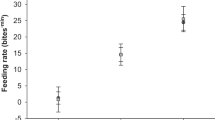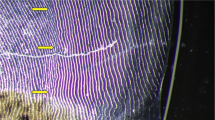Abstract
The tarpon Megalops atlanticus is a tropical to subtropical species whose pole-ward distribution is thought to be limited by low water temperatures. In the western north Atlantic Ocean juvenile tarpon occur in estuaries of the South Atlantic Bight (SAB) north of Florida near the northern limit of its distribution, but it is currently unknown whether these individuals can survive winter, grow to maturity, and contribute to the adult population. As a first step to determine whether juvenile tarpon can survive winter conditions in the SAB, we conducted laboratory experiments to estimate minimum lethal temperatures of tarpon exposed to 1) ambient fluctuating winter water conditions and 2) a constant rate of temperature decline. Juvenile tarpon exposed to ambient winter water conditions had a mean ± standard deviation (SD) minimum lethal temperature of 13.7 ± 3.4 °C. When exposed to a constant rate of temperature decline (2 °C day−1), mean ± SD minimum lethal temperature (9.2 ± 0.8 °C) was lower than when tarpon were exposed to ambient fluctuating conditions. A combination of our results with all published data on the cold tolerance of juvenile tarpon resulted in an overall mean ± SD minimum lethal temperature of 12.0 ± 2.8 °C. Based on available long-term temperature records from SAB estuaries, overwinter survival of juvenile tarpon is unlikely in most aquatic habitats (e.g., tidal creeks, flats, open water). Similar to other estuarine transient fishes, juvenile tarpon likely exploit seasonably favorable nursery habitats and then migrate to other locations to overwinter.



Similar content being viewed by others
References
Able KW, Curran MC (2008) Winter mortality in some temperate young-of-the-year fishes. Bull NJ Acad Sci 53:1–5
Allen DM, Allen WB, Feller RF, Plunket JS (2014) Site Profile of the North Inlet - Winyah Bay National Estuarine Research Reserve. North Inlet - Winyah Bay National Estuarine Research Reserve, Georgetown, SC pp 432
Anweiler KV, Arnott SA, Denson MR (2014) Low-temperature tolerance of juvenile spotted seatrout in South Carolina. Trans Am Fish Soc 143:999–1010
Ault JS, Humston R, Larkin MF, Perusquia E, Farmer NA, Luo J, Zurcher N, Smith SG, Barbieri LR, Posada JM (2008) Population dynamics and resource ecology of Atlantic tarpon and bonefish. In: Ault JS (ed) Biology and management of the world tarpon and bonefish fisheries. CRC Press, Boca Raton, pp 217–258
Beebe W (1927) A tarpon nursery in Haiti. Bulletin of the New York Zoological Society 30:141–145
Beitinger TL, Bennett WA, McCauley RW (2000) Temperature tolerances of north American freshwater fishes exposed to dynamic changes in temperature. Environ Biol Fish 58:237–275
Bennett WA, Currie RJ, Wagner PF, Beitinger TL (1997) Cold tolerance and potential overwintering of the red-bellied piranha Pygocentrus nattereri in the United States. Trans Am Fish Soc 126:841–849
Bennett WA, Judd FW (1992a) Comparison of methods for determining low temperature tolerance: experiments with pinfish, Lagodon rhomboides. Copeia 1992:1059–1065
Bennett WA, Judd FW (1992b) Factors affecting the low-temperature tolerance of Texas pinfish. Trans Am Fish Soc 121:659–666
Carveth CJ, Widmer AM, Bonar SA, Simms JR (2007) An examination of the effects of chronic static and fluctuating temperature on the growth and survival of spikedace, Meda fulgida, with implications for management. J Therm Biol 32:102–108
Crabtree RE (1995) Relationship between lunar phase and spawning activity of tarpon, Megalops atlanticus, with notes on the distribution of larvae. Bull Mar Sci 56:895–899
Crabtree RE, Cyr EC, Bishop RE, Falkenstein LM, Dean JM (1992) Age and growth of tarpon, Megalops atlanticus, larvae in the eastern Gulf of Mexico, with notes on relative abundance and probable spawning areas. Environ Biol Fish 35:361–370
Dahlberg MD, Smith FG (1970) Mortality of estuarine animals due to cold on the Georgia coast. Ecology 51:931–933
Fangue NA, Bennett WA (2003) Thermal tolerance repsonses of laboratory-acclimated and seasonally acclimatized Atlantic stingray, Dasyatis sabina. Copeia 2003:315–325
Fry FEJ, Hart JS, Walker KF (1946) Lethal temperature relations for a sample of young speckled trout, Salvelinus fontinalis. University of Toronto Studies Biological Series, No. 54. Publications of the Ontario Fisheries Research Laboratory 66:9–35
Gilmore RG, Cooke DW, Donohoe CJ (1982) A comparison of the fish populations and habitat in open and closed salt marsh impoundments in east-central Florida. Northeast Gulf Science 5:25–37
Gunter G (1941) Death of fishes due to cold on the Texas coast, January, 1940. Ecology 22:203–208
Gunter G (1951) Destruction of fishes and other organisms on the south Texas coast by the cold wave of January 28-February 3, 1951. Ecology 32:731–736
Hales LS Jr, Able KW (2001) Winter mortality, growth, and behavior of young-of-the-year of four coastal fishes in New Jersey (USA) waters. Mar Biol 139:45–54
Harrington RW Jr (1966) Changes through one year in the growth rates of tarpon, Megalops atlanticus Valenciennes, reared from mid-metamorphosis. Bull Mar Sci 16:863–883
Hildebrand SF (1934) The capture of a young tarpon, Tarpon atlanticus, at Beaufort, North Carolina. Copeia 1934:45–46
Howells RG (1985) Cold tolerance of juvenile tarpon in fresh water. Annual Proceedings of the Texas Chapter American Fisheries Society 8:26–34
Hurst TP (2007) Causes and consequences of winter mortality in fishes. J Fish Biol 71:315–345
Hurst TP, Conover DO (2002) Effects of temperature and salinity on survival of young-of-the-year Hudson River striped bass (Morone saxatilis): implications for optimal overwintering habitats. Can J Fish Aquat Sci 59:787–795
Hutchison VH (1976) Factors influencing thermal tolerance of individual organisms. In: Esch GW, McFarlane RW (eds) Thermal ecology II, ERDA symposium series (40). US Department of Energy, Washington DC, pp 10–26
Kerfoot JR Jr (2012) Thermal tolerance of the invasive Belonesox belizanus, pike killifish, throughout ontogeny. J Exp Zool 317:266–274
Kimball ME, Miller JM, Whitfield PE, Hare JA (2004) Thermal tolerance and potential distribution of invasive lionfish (Pterois volitans/miles complex) on the east coast of the United States. Mar Ecol Prog Ser 283:269–278
Korsman B, Kimball ME, Hernandez FJ Jr (2017) Spatial and temporal variability in ichthyoplankton communities ingressing through two adjacent inlets along the southeastern US Atlantic coast. Hydrobiologia. doi:10.1007/s10750-017-3131-5
Lankford TE Jr, Targett TE (2001a) Low-temperature tolerance of age-0 Atlantic croakers: recruitment implications for U.S. mid-Atlantic estuaries. Trans Am Fish Soc 130:236–249
Lankford TE Jr, Targett TE (2001b) Physiological performance of young-of-the-year Atlantic croakers from different Atlantic coast estuaries: implications for stock structure. Trans Am Fish Soc 130:367–375
Lund WA Jr, Maltezos GC (1970) Movements and migrations of the bluefish, Pomatomus saltatrix, tagged in waters of New York and southern New England. Trans Am Fish Soc 99:719–725
Luo J, Ault JS (2012) Vertical movement rates and habitat use of Atlantic tarpon. Mar Ecol Prog Ser 467:167–180
Luo J, Ault JS, Larkin MF, Humston R, Olson DB (2008) Seasonal migratory patterns and vertical habitat utilization of Atlantic tarpon (Megalops atlanticus) from satellite PAT tags. In: Ault JS (ed) Biology and management of the world tarpon and bonefish fisheries. CRC Press, Boca Raton, pp 275–299
McBride RS, Able KW (1998) Ecology and fate of butterflyfishes, Chaetodon spp., in the temperate, western North Atlantic. Bull Mar Sci 63:401–416
McBride RS, McKown KA (2000) Consequences of dispersal of subtropically spawned crevalle jacks, Caranx hippos, to temperate estuaries. Fish Bull 98:528–538
McGovern JC, Wenner CA (1990) Seasonal recruitment of larval and juvenile fishes into impounded and non-impounded marshes. Wetlands 10:203–221
Moffett AW, Randall JE (1957) The Roger Firestone tarpon investigation progress report. University of Miami, Coral Gables, pp 18
Prentice JA (1989) Low-temperature tolerance of southern flounder in Texas. Trans Am Fish Soc 118:30–35
R Core Team (2015) R: a language and environment for statistical computing. R Foundation for Statistical Computing. Vienna, Austria. http://www.R-project.org/
Rajaguru S (2002) Critical thermal maximum of seven estuarine fishes. J Therm Biol 27:125–128
Reber CM, Bennett WA (2007) The influence of thermal parameters on the acclimation responses of pinfish Lagodon rhomboides exposed to static and decreasing low temperatures. J Fish Biol 71:833–841
Reyier EA, Shenker JM (2007) Ichthyoplankton community structure in a shallow subtropical estuary of the Florida Atlantic coast. Bull Mar Sci 80:267–293
Rickards WL (1966) A study of the ecology of first-year tarpon, Megalops atlantica Valenciennes, in a Georgia salt-marsh with laboratory studies of growth rates and ecological growth efficiencies. M.S., University of Georgia, Athens, pp 67
Rickards WL (1968) Ecology and growth of juvenile tarpon, Megalops atlanticus, in a Georgia salt marsh. Bull Mar Sci 18:220–239
Robinson KF, Jennings CA (2014) Productivity of functional guilds of fishes in managed wetlands in coastal South Carolina. J Fish Wildl Manag 5:70–86
Schwartz FJ (1964) Effects of winter water conditions on fifteen species of captive marine fishes. Am Midl Nat 71:434–444
Shenker JM, Cowie-Mojica E, Crabtree RE, Patterson HM, Stevens C, Yakubik K (2002) Recruitment of tarpon (Megalops atlanticus) leptocephali into the Indian River lagoon, Florida. Contrib Mar Sci 35:55–69
Slater JJ, Lankford TE Jr, Buckel JA (2007) Overwintering ability of young-of-the-year bluefish Pomatomus saltatrix: effect of ration and cohort of origin on survival. Mar Ecol Prog Ser 339:259–269
Stein W III, Shenker JM, O'Connell MT (2016) A contribution to the life history of tarpon (Megalops atlanticus) in the northern Gulf of Mexico. Southeast Nat 15:496–512
Storey M (1937) The relation between normal range and mortality of fishes due to cold at Sanibel Island, Florida. Ecology 18:10–26
Storey M, Gudger EW (1936) Mortality of fishes due to cold at Sanibel Island, Florida, 1886-1936. Ecology 17:640–648
Tucker JW Jr, Hodson RG (1976) Early and mid-metamorphic larvae of the tarpon, Megalops atlantica, from the Cape Fear River estuary, North Carolina, 1973-74. Chesap Sci 17:123–125
Tuckett QM, Ritch JL, Lawson KM, Lawson LL Jr, Hill JE (2016) Variation in cold tolerance in escaped and farmed non-native green swordtails (Xiphophorus hellerii) revealed by laboratory trials and field introductions. Biol Invasions 18:45–56
Wade RA (1962) The biology of the tarpon, Megalops atlanticus, and the ox-eye, Megalops cyprinoides, with emphasis on larval development. Bull Mar Sci Gulf Caribb 12:545–622
Wade RA (1968) Ecology of juvenile tarpon, with special attention to the effects of dieldrin on two associated species, Cyprinodon variegatus and Poecilia latipinna. Ph.D., University of Miami, Coral Gables, pp 130
Whitehurst A, Robinette HR (1994) Tolerance of juvenile red drum Sciaenops ocellatus to rapidly decreasing water temperatures. J World Aquacult Soc 25:225–229
Wuenschel MJ, Able KW, Buckel JA, Morley JW, Lankford TE, Jr., Branson AC, Conover DO, Drisco D, Jordaan A, Dunton K, Secor DH, Woodland RJ, Juanes F, Stormer D (2012a) Recruitment patterns and habitat use of young-of-the-year bluefish along the United States east coast: insights from coordinated coastwide sampling. Rev Fish Sci 20:80-102
Wuenschel MJ, Hare JA, Kimball ME, Able KW (2012b) Evaluating juvenile thermal tolerance as a constraint on adult range of gray snapper (Lutjanus griseus): a combined laboratory, field and modeling approach. J Exp Mar Biol Ecol 436–437:19–27
Zale AV, Merrifield SG (1989) Species profiles: life histories and environmental requirements of coastal fishes and invertebrates (South Florida) - ladyfish and tarpon. U.S. Fish Wildl. Serv. Biol. Rep. 82(11.104). U.S. Army Corps of Engineers, TR EL-82-4, pp 17
Zerbi A, Aliaume C, Miller JM (1999) A comparison between two tagging techniques with notes on juvenile tarpon ecology in Puerto Rico. Bull Mar Sci 64:9–19
Acknowledgements
This project was funded by the Bonefish and Tarpon Trust and we especially thank A. Adams and J. Wilson at BTT for their assistance. We would also like to thank J. Collington, J. Dozier, H. Evans, B. Gamble, J. Lee, F. Sim, and Z. Simpson from the South Carolina Department of Natural Resources Tom Yawkey Wildlife Center as well as D. Allen, J. Blakely, S. Forehand, P. Kenny, K. Powers, and T. Thomas at the USC Baruch Marine Field Laboratory for their assistance during this study. The suggestions of L. Rozas, D. Allen, and two anonymous reviewers improved the manuscript. This research was conducted in accordance with the guidelines set forth in the University of South Carolina IACUC Animal Care and Use Protocols #2273-101047-093015 and #2154-100810-040814.
Author information
Authors and Affiliations
Corresponding author
Rights and permissions
About this article
Cite this article
Mace, M.M., Haffey, E.R. & Kimball, M.E. Low-temperature tolerance of juvenile tarpon Megalops atlanticus . Environ Biol Fish 100, 913–922 (2017). https://doi.org/10.1007/s10641-017-0619-9
Received:
Accepted:
Published:
Issue Date:
DOI: https://doi.org/10.1007/s10641-017-0619-9




